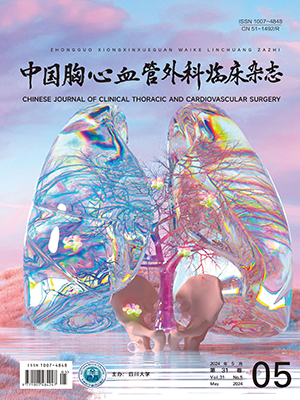| 1. |
Bichell DP, Geva T, Bacha EA, et al. Minimal access approach for the repair of atrial septal defect:the initial 135 patients. Ann Thorac Surg, 2000, 70(1):115-118.
|
| 2. |
Schreiber C, Bleiziffer S, Kostolny M, et al. Minimally invasive midaxillary muscle sparing thoracotomy for atrial septal defect closure in prepubescent patients. Ann Thorac Surg, 2005, 80(2):673-676.
|
| 3. |
Dave HH, Comber M, Solinger T, et al. Mid-term results of right axillary incision for the repair of a wide range of congenital cardiac defects. Eur J Cardiothorac Surg, 2009, 35(5):864-869.
|
| 4. |
Sebastian VA, Guleserian KJ, Leonard SR, et al. Ministernotomy for repair of congenital cardiac disease. Interact Cardiovasc Thorac Surg, 2009, 9(5):819-821.
|
| 5. |
Murashita T, Hatta E, Ooka T, et al. Minimal access surgery for the repair of simple congenital heart defects:factors affecting hospital stay after surgery. Jpn J Thorac Cardiovasc Surg, 2004, 52(3):127-134.
|
| 6. |
Ding C, Wang C, Dong A, et al. Anterolateral minithoracotomy versus median sternotomy for the treatment of congenital heart defects:a meta-analysis and systematic review. J Cardiothorac Surg, 2012, 7:43.
|
| 7. |
Hongxin L, Wenbin G, Lijun S, et al. Intraoperative device closure of secundum atrial septal defect with a right anterior minithoracotomy in 100 patients. J Thorac Cardiovasc Surg, 2007, 134(4):946-951.
|
| 8. |
Mishra S, Tomar M, Malhotra R, et al. Comparison between transcatheter closure and minimally invasive surgery for fossa ovalis atrial septal defect:a single institutional experience. Indian Heart J, 2008, 60(2):125-132.
|
| 9. |
Sarris GE, Kirvassilis G, Zavaropoulus P, et al. Surgery for complications of trans-catheter closure of atrial septal defect:a multi-institutional study from the European Congenital Heart Surgeons Association. Eur J Cardiothorac Surg, 2010, 37(6):1285-1290.
|
| 10. |
Menkis AH, Martin J, Cheng DC, et al. Drug, devices, technologies, and techniques for blood management in minimally invasive and conventional cardiothoracic surgery:a consensus statement from the International Society for Minimally Invasive Cardiothoracic Surgery(ISMICS)2011. Innovations(Phila), 2012, 7(4):229-241.
|
| 11. |
Suchon E, Pieculewicz M, Tracz W, et al. Transcatheter closure as an alternative and equivalent method to the surgical treatment of atrial septal defect in adults:comparison of early and late results. Med Sci Monit, 2009, 15(12):612-617.
|
| 12. |
Zhu P, Sun Y, Yang Q, et al. Intraoperative device closure of atrial septal defects with minimal transthoracic invasion:a singe-center experience. Tex Heart Inst J, 2013, 40(3):256-260.
|
| 13. |
Yan L, Zhou ZC, Li HP, et al. Right vertical infra-axillary mini-incision for repair of simple congenital heart defects:a matched-pair analysis. Eur J Cardiothorac Surg, 2013, 43(1):136-141.
|
| 14. |
李保军, 谢家声, 李保田, 等.右腋下垂直小切口心脏不停跳心内直视手术135例.中国胸心血管外科临床杂志, 2007, 14(2):152-153.
|
| 15. |
杨秀滨, 王东进, 吴清玉, 等.微创心脏不停跳下房间隔缺损修补术(附46例报告).中国微创外科杂志, 2001, 1(5):284-285.
|
| 16. |
Yang X, Wang D, Wu Q. Repair of atrial septal defect through a minimal right vertical infra-axillary thoracotomy in a beating heart. Ann Thorac Surg, 2001, 71(6):2053-2054.
|
| 17. |
Chen L, Hao J, Ma RY, et al. The application of on-pump beating-heart surgery for partial atrioventricular septal defect:a report of 87 cases. Heart Surg Forum, 2013, 16(5):257-263.
|
| 18. |
何巍, 林辉, 郑宝石, 等.浅低温体外循环心脏跳动中施术对心肌保护的实验研究.中华胸心血管外科杂志, 2001, 17(2):96-98.
|
| 19. |
马瑞彦, 杨宗英, 钟前进, 等.浅低温体外循环心脏跳动下修复3岁以下房间隔缺损134例.第三军医大学学报, 2008, 30(18):1762-1763.
|




